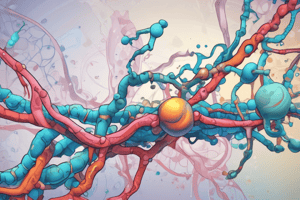Podcast
Questions and Answers
Which enzyme class recognizes and binds to the 3' end of mRNA?
Which enzyme class recognizes and binds to the 3' end of mRNA?
- Deadenylation complex
- Decapping enzymes
- Exoribonucleases (correct)
- RNA-induced silencing complex
What is the function of decapping enzymes in mRNA degradation?
What is the function of decapping enzymes in mRNA degradation?
- Hydrolyze the phosphodiester bonds, releasing nucleotides
- Recruit the RNA-induced silencing complex
- Recognize and bind to the poly(A) tail
- Remove the 7-methylguanosine (m7G) cap from the 5' end of mRNA (correct)
What is the primary function of Nonsense-Mediated Decay (NMD)?
What is the primary function of Nonsense-Mediated Decay (NMD)?
- Recognition of the m7G cap from the 5' end of mRNA
- Surveillance mechanism to degrade mRNAs with premature stop codons (correct)
- Removal of the poly(A) tail from the 3' end of mRNA
- MicroRNA-mediated degradation of target mRNAs
How do microRNAs (miRNAs) induce degradation of target mRNAs?
How do microRNAs (miRNAs) induce degradation of target mRNAs?
What is the role of deadenylation in mRNA degradation?
What is the role of deadenylation in mRNA degradation?
Which complex is responsible for deadenylation?
Which complex is responsible for deadenylation?
What is the main reason for the difference in stability between mRNA in prokaryotes and eukaryotes?
What is the main reason for the difference in stability between mRNA in prokaryotes and eukaryotes?
What is the purpose of having different mRNA stabilities in cells?
What is the purpose of having different mRNA stabilities in cells?
Why do mRNAs in human cells have longer lifetimes compared to E. coli?
Why do mRNAs in human cells have longer lifetimes compared to E. coli?
What happens to mRNA molecules when a cell divides?
What happens to mRNA molecules when a cell divides?
Why are some mRNAs more unstable than others?
Why are some mRNAs more unstable than others?
What is the relationship between mRNA stability and the lifespan of a cell?
What is the relationship between mRNA stability and the lifespan of a cell?
Why do cells have different mRNA stability for different genes?
Why do cells have different mRNA stability for different genes?
What is the effect of rapid mRNA degradation on cellular energy expenditure?
What is the effect of rapid mRNA degradation on cellular energy expenditure?
Why do some genes require more rapid mRNA degradation than others?
Why do some genes require more rapid mRNA degradation than others?
Why is RNA with a non-coding function relatively more stable?
Why is RNA with a non-coding function relatively more stable?
What is the main reason for the degradation of RNA molecules?
What is the main reason for the degradation of RNA molecules?
What is the main difference between the stability of DNA and RNA?
What is the main difference between the stability of DNA and RNA?
Why are defective RNA molecules eliminated?
Why are defective RNA molecules eliminated?
What is the main advantage of RNA degradation?
What is the main advantage of RNA degradation?
What is the relationship between RNA stability and cellular growth?
What is the relationship between RNA stability and cellular growth?
Why are non-coding RNA molecules more stable than messenger RNA molecules?
Why are non-coding RNA molecules more stable than messenger RNA molecules?
What is the main consequence of not degrading RNA molecules?
What is the main consequence of not degrading RNA molecules?
What is the consequence of the balance between the rates of synthesis and degradation of RNA?
What is the consequence of the balance between the rates of synthesis and degradation of RNA?
What is the purpose of degrading incorrect RNA molecules?
What is the purpose of degrading incorrect RNA molecules?
What determines the stability of an RNA molecule?
What determines the stability of an RNA molecule?
What is the relationship between the rate of transcription and the rate of degradation?
What is the relationship between the rate of transcription and the rate of degradation?
What is the purpose of the 'model pool'?
What is the purpose of the 'model pool'?
What is the consequence of a low degradation rate for an RNA molecule?
What is the consequence of a low degradation rate for an RNA molecule?
What is the role of the RNA polymerase in transcription?
What is the role of the RNA polymerase in transcription?
What is the significance of the half-life of an RNA molecule?
What is the significance of the half-life of an RNA molecule?
Flashcards are hidden until you start studying
Study Notes
mRNA Degradation
Exoribonucleases
- Exoribonucleases are a class of enzymes that degrade mRNA from the 3' end
- Examples: RNase II and RNase R
- Mechanism:
- Recognize and bind to the 3' end of mRNA
- Hydrolyze the phosphodiester bonds, releasing nucleotides
- Processive degradation: continue to degrade the mRNA until it is completely broken down
Decapping
- Decapping is the removal of the 7-methylguanosine (m7G) cap from the 5' end of mRNA
- Decapping enzymes: Dcp1 and Dcp2
- Mechanism:
- Recognize and bind to the m7G cap
- Hydrolyze the cap, removing it from the mRNA
- Exoribonucleases can then access the 5' end and degrade the mRNA
Nonsense-Mediated Decay (NMD)
- NMD is a surveillance mechanism that degrades mRNAs with premature stop codons
- Recognizes and degrades aberrant mRNAs to prevent the synthesis of truncated proteins
- Mechanism:
- Recognition of the premature stop codon by the ribosome
- Recruitment of the NMD machinery, including UPF1 and UPF2
- Degradation of the mRNA by decapping and exoribonucleolytic degradation
MicroRNA-mediated Degradation
- MicroRNAs (miRNAs) are small RNAs that bind to target mRNAs and induce degradation
- Mechanism:
- miRNA binding to the 3' UTR of the target mRNA
- Recruitment of the RNA-induced silencing complex (RISC)
- Argonaute protein-mediated degradation of the mRNA
- Deadenylation and exoribonucleolytic degradation of the mRNA
Deadenylation
- Deadenylation is the removal of the poly(A) tail from the 3' end of mRNA
- Deadenylation is a key step in mRNA degradation
- Mechanism:
- Recognition of the poly(A) tail by deadenylases (e.g., CCR4-NOT complex)
- Shortening of the poly(A) tail, making the mRNA susceptible to degradation by exoribonucleases
Studying That Suits You
Use AI to generate personalized quizzes and flashcards to suit your learning preferences.



